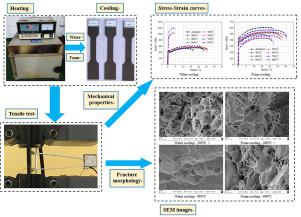当前位置:
X-MOL 学术
›
J. Constr. Steel Res.
›
论文详情
Our official English website, www.x-mol.net, welcomes your feedback! (Note: you will need to create a separate account there.)
Mechanical properties of Q345 structural steel after artificial cooling from elevated temperatures
Journal of Constructional Steel Research ( IF 4.1 ) Pub Date : 2021-01-01 , DOI: 10.1016/j.jcsr.2020.106432 Chuntao Zhang , Ruheng Wang , Li Zhu
Journal of Constructional Steel Research ( IF 4.1 ) Pub Date : 2021-01-01 , DOI: 10.1016/j.jcsr.2020.106432 Chuntao Zhang , Ruheng Wang , Li Zhu

|
Abstract Water cannot be used to effectively extinguish fires that occur in chemical plants, oil and gas pipelines, and other flammable and combustible liquid storage structures. In such cases, firefighting foam is often used as a fire-extinguishing agent. In this study, we experimentally investigate the mechanical properties of Q345 steel after subjecting it to temperatures of 200–900 °C, followed by artificial cooling using water or firefighting foam. The fire-affected specimens are subjected to tensile tests to observe their fracture characteristics and obtain their stress–strain curves. Below an exposure temperature of 600 °C, the mechanical properties of Q345 steel remain almost entirely unchanged, irrespective of the cooling method. Above 600 °C, the mechanical properties of Q345 steel experience significant changes based on the exposure temperature and the type of cooling method. When Q345 steel is exposed to temperatures of 800 °C and 900 °C and cooled using water, its yield strength and ultimate strength increase significantly. In contrast, the ductility of the Q345 steel that is water cooled from temperatures of 600–900 °C rapidly decreases with the increase in temperature. When Q345 steel is exposed to temperatures of 600–900 °C and cooled using firefighting foam, it experiences a significant reduction in both yield strength and ultimate strength. In contrast, the ductility of Q345 steel that is cooled using firefighting foam does not change significantly. Subsequently, the macroscopic and microscopic fracture morphologies are also analyzed to better understand the changes in the mechanical properties of Q345 steel. Finally, empirical equations are proposed to predict the mechanical properties of fire-affected Q345 steel that is cooled using water or firefighting foam.
中文翻译:

Q345结构钢高温人工冷却后力学性能
摘要 水不能有效扑灭发生在化工厂、油气管道和其他易燃、可燃液体储存结构中的火灾。在这种情况下,消防泡沫通常用作灭火剂。在这项研究中,我们通过实验研究了 Q345 钢在 200-900 °C 的温度下的机械性能,然后使用水或消防泡沫进行人工冷却。对受火影响的试样进行拉伸试验以观察其断裂特性并获得其应力-应变曲线。在 600 °C 的暴露温度以下,Q345 钢的机械性能几乎完全保持不变,与冷却方法无关。600℃以上,Q345 钢的机械性能会根据暴露温度和冷却方法类型发生显着变化。Q345钢暴露在800℃和900℃的温度下并用水冷却时,其屈服强度和极限强度显着增加。相比之下,Q345 钢从 600-900 °C 的温度进行水冷,其延展性随着温度的升高而迅速下降。当 Q345 钢暴露在 600-900 °C 的温度下并使用消防泡沫冷却时,它的屈服强度和极限强度都会显着降低。相比之下,使用消防泡沫冷却的 Q345 钢的延展性没有显着变化。随后,还分析了宏观和微观断口形貌,以更好地了解 Q345 钢力学性能的变化。最后,提出了经验方程来预测用水或消防泡沫冷却的受火灾影响的 Q345 钢的机械性能。
更新日期:2021-01-01
中文翻译:

Q345结构钢高温人工冷却后力学性能
摘要 水不能有效扑灭发生在化工厂、油气管道和其他易燃、可燃液体储存结构中的火灾。在这种情况下,消防泡沫通常用作灭火剂。在这项研究中,我们通过实验研究了 Q345 钢在 200-900 °C 的温度下的机械性能,然后使用水或消防泡沫进行人工冷却。对受火影响的试样进行拉伸试验以观察其断裂特性并获得其应力-应变曲线。在 600 °C 的暴露温度以下,Q345 钢的机械性能几乎完全保持不变,与冷却方法无关。600℃以上,Q345 钢的机械性能会根据暴露温度和冷却方法类型发生显着变化。Q345钢暴露在800℃和900℃的温度下并用水冷却时,其屈服强度和极限强度显着增加。相比之下,Q345 钢从 600-900 °C 的温度进行水冷,其延展性随着温度的升高而迅速下降。当 Q345 钢暴露在 600-900 °C 的温度下并使用消防泡沫冷却时,它的屈服强度和极限强度都会显着降低。相比之下,使用消防泡沫冷却的 Q345 钢的延展性没有显着变化。随后,还分析了宏观和微观断口形貌,以更好地了解 Q345 钢力学性能的变化。最后,提出了经验方程来预测用水或消防泡沫冷却的受火灾影响的 Q345 钢的机械性能。


























 京公网安备 11010802027423号
京公网安备 11010802027423号